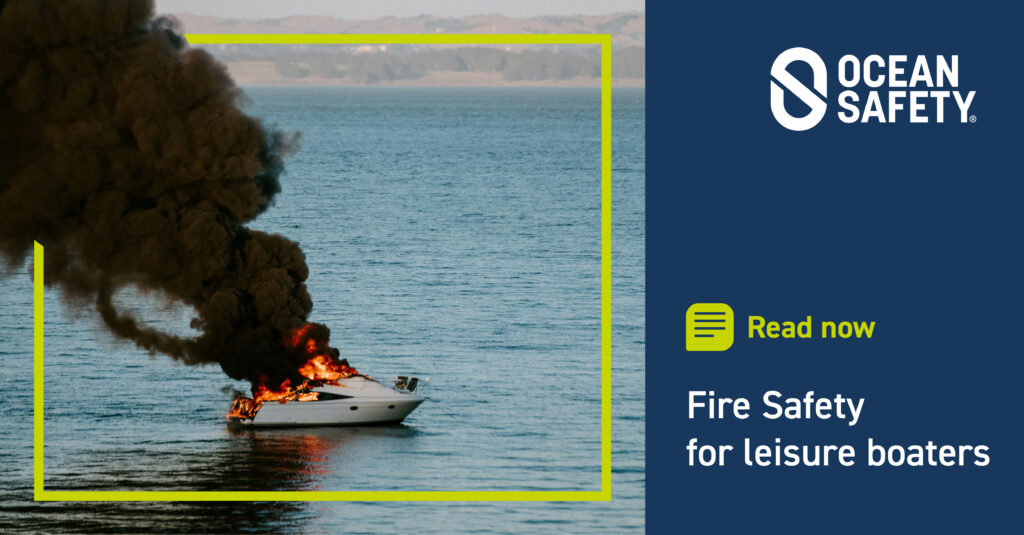Fire is one of the biggest threats to safety on board any boat. A vessel’s hull and interior are made of highly flammable materials which means a fire can spread quickly, emitting flames, smoke and noxious fumes that can engulf a cabin within seconds.
It’s therefore crucial to have a plan for what to do if a fire breaks out on board your boat, and ensure all crew are aware of procedure and where safety equipment is stowed.
Minimise risk by ensuring any potential sources of ignition – including gas, electrical, battery and engine systems – are in good order and regularly maintained. Check pipes and fittings carefully, stow flammable liquids such as petrol or cooking oils correctly, and clean up any spillages immediately.
Initially, you may not realise a fire has broken out if, perhaps, you’re sleeping or on deck. A smoke detector is therefore an essential first warning; make sure to test it regularly and consider installing more than one in different cabin areas.
Once you have discovered a fire, send a Mayday and activate the boat’s EPIRB. Be prepared to abandon ship into the liferaft; any crew not fighting the fire should assemble on deck wearing lifejackets. Speedy reactions are vital as it can take just seconds before a fire on board becomes out of control; never block an escape route.
Consider having a Smoke Hood on board, stowed close to the companion way, this will at least allow an option to be able to go down below to retrieve a casualty and will dramatically reduce the risk of the ‘rescuer’ becoming a 2nd casualty.
Engine fires can be tackled with an automatic extinguisher fitted inside the engine compartment. Otherwise, there should be a small aperture in the door through which you can aim a fire extinguisher nozzle. Never open the compartment to fight the fire as this will allow oxygen to pour in and fuel it further.
If you have to manually fight the blaze, first identify the source and if possible, isolate whatever is fuelling the fire, by turning off gas, electricity or fuel.
Fire extinguishers come in different types for use according to the source of fire, and it’s important to familiarise yourself – and your crew – with which type to use and when; using the wrong type is dangerous as it can cause a fire to flare up rather than supress it.
Given the rise in popularity of electric-powered toys aboard boats, there are now fire extinguishers specifically designed for use on lithium-ion battery fires (not the same as standard lithium batteries which need a Class D L2 Powder Extinguisher) which can often build in intensity as they burn in a process known as thermal runaway, and will easily re-ignite if not tackled with a suitable solution.
Whichever fire extinguisher is required, you will need to deploy them quickly to tackle the fire effectively; always aim at the base of the fire. Placing extinguishers at the exit to each cabin is recommended where they can be easily located but without obstructing movement around the boat.
The number of fire extinguishers you need to carry on board depends on the internal volume of the yacht. Ensure the volume of extinguisher discharge is sufficient for the size of boat, with reserve in case some isn’t deployed effectively (dry powder can be blown away in the wind, for example) or in case of a second flare up. Fire extinguishers need to be checked and serviced regularly.
If the fire you are fighting can be put out using water, a fire bucket with lanyard can provide a simple but effective solution. Similarly, for large boats, fire hoses and hand pumps can provide a more powerful jet of water to help extinguish fire.
For a small galley fire, a fire blanket can be used to smother it. Affix your fire blanket to the bulkhead near – not behind – the cooker; a slimline option is preferable so as to be as unobtrusive as possible day to day. When deploying, wrap the edges of the blanket around your hand first to help protect your hands from the flames.
Other equipment essentials include a fire axe and a fireman’s torch, while larger vessels carrying breathing apparatus may also require a crew tally board to track deployment, steel-centred fireman’s safety line for crewmembers to follow routes in and out, and a fire plan holder.
Regular briefings and updates to crew on availability and location of such equipment are essential so it can be deployed should the situation ever arise.
Once you have extinguished a fire on board, thoroughly ventilate the interiors, including any lockers and bilges where gasses could have settled. Maintain a watch on the vessel for several hours in case of reignition.

